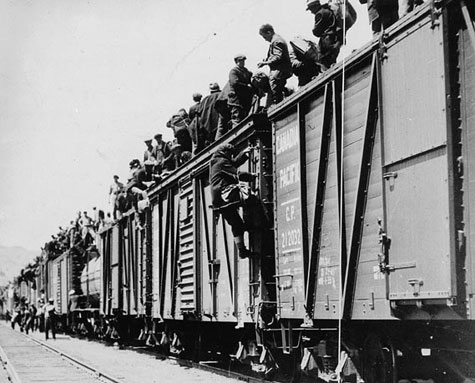
Contributed by Nadine Bloch
“The path is made by walking.”Antonio Machado
Common Uses
To link disparate locations that seek to have impact on a common issue; to model alternative community; to demonstrate commitment to a cause through endurance; to physically embody a pathway to an alternative.
We learn to walk at a very early age, and almost simultaneously, we learn the power of being able to move ourselves toward places we want to go (that pile of toys) or away from places we want to leave (that plate of smashed peas). Each step of our path embodies the message.
People’s resistance stories are full of walks, treks, sea voyages and even flights. Over the millennia of human existence, entire communities have packed up and voted with their feet, moving away from untenable situations to more fertile lands. In the last century, extended marches have been used broadly and strategically as a platform for outreach and mobilization, and as a visible expression of issues.
India’s Salt March of 1932 is likely the best-known example of a mass, many-day trek see CASE: The Salt March. Gandhi conceived of this march as a living lesson for India, creating a community, literally one step at a time, that both supported and embodied an independent India.
Many other treks have followed suit, usually with a commitment to demonstrate an ideal or alternative way of living. The 1986 Great Peace March for Global Nuclear Disarmament flourished during its cross-continental trek, arriving in Washington, D.C., with 1,500 marchers and thousands more supporters. In the course of the 3,700 logged miles, the marchers not only educated and agitated for action on nuclear disarmament, but also built a participatory mobile city.
Not all treks model alternative social or living structures; some focus on specific strategic functions of the tactic itself. In 2010, four immigrant students embarked on a 1,500-mile march to Washington, D.C., to support immediate passage of the DREAM (Development, Relief and Education of Alien Minors) Act and a moratorium on deportations of eligible students. The Trail of Dreams see CASE: Trail of Dreams embodied the impossible hurdles placed on the path to success of immigrants in the USA.
Many forms of transportation, from bicycles to trains and even sailboats, have been used in treks. In the 1935 On-to-Ottawa trek, hundreds of unemployed Canadian workers boarded boxcars in Vancouver to take their grievances to the national capital. Their basic demands proved so threatening to the government that they were physically stopped from reaching Ottawa, but the unrest that fueled their trek soon brought down the conservative government. The trek tactic can prove a potent tool in focusing attention on an issue.
Key Principle at work
The routes of treks are often strategically chosen to make the invisible visible, bringing issues that are currently under the radar into the public dialogue.
Potential Pitfalls
All of these mobile protests require immense amounts of logistical support before, during, and after the action itself. Sometimes this burden can prove too heavy and the logistics can overwhelm the organizers, leaving the strategy unrealized. When things go badly, the physical requirements of the trek or ride can exhaust members and burn out the broader support network. Make sure to allow adequate preparation time and gather appropriate resources to ensure success.